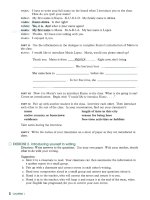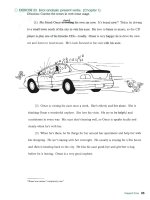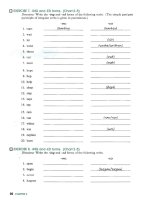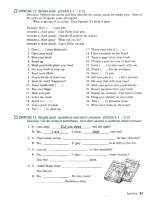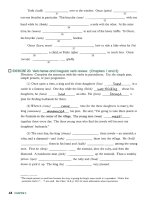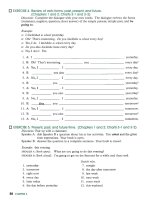Fundamentals of english grammar third edition part 1 docx
Bạn đang xem bản rút gọn của tài liệu. Xem và tải ngay bản đầy đủ của tài liệu tại đây (306.11 KB, 7 trang )
FUNDAMENTALS
OF
'
GRAMMAR
Third
Edition
,'i
f:
,I
vn7
-k
-
6th
Am
we.
Betty
Schrampfer
Azar
FUNDAMENTALS
OF
GRamR
Third
Edition
LONGMAN ON
THE
WEB
Visit us
at
longman.com
for online resources
for
teachers and students.
For the Azar Companion Website, visit
longmanxom/gmmmanxchanga.
Longman English Success
(englishsucnrsxom)
offers online courses covering
General English, Business English, and Exam Preparation.
FUNDAMENTALS OF
NGL
GRAMMAR
Third
Edition
with
Answer
Key
Betty
Schrampfer
Azar
Fundament&
of
English
Grammsr,Third
Edition
.
.
WithAnawerKey
&*$@
.i,,*,l
-1.1
~:,
i'
.>
.>
,;;;
,v.
:-
q'
.
,
.,
,
Copyright
O
2003,1992,1985 by Betty Schrampfer Azar
:.
.
25
.:
All rights reserved.
,-i
:A.
.
;.
':r.~~,
8
-
~ ?
&,j;
,
'f"'
No part of this publication may be reproduced,
i
*.e
-&
8
;
stored
in
a
retrieval system, or transmitted
.?&'
:@:
in
any form or by any means, electronic, mechanical,
b.
.5.
.
.
photocopying, recording, or otherwise,
without the prior penniesion of the publisher.
Azar
Associates
Shelley Hanle, Editor&&
Susan
Van
Etten,
Menage
Pcmon Education, 10 Bank Street,White Plains,
lyy
1
Vice president, director of publishing: Allen As
Editorial manager: Pam Fishman
-
-
Proien manager: Margo Grant
Development editor: Janet Johnston
a*.
-
"*:i'.g
Vice president, director of design and production: Rhea Banker
Director of electronic production:
Executive managing edi~or:
Linda
Production manager:
Ray
Keating
Production editor: Robert Ruvo
Director of manufacturing: Pauice Fraccio
Senior manufacturing buyer: Edie Pullman
'
.I
Cover design: Monika Popowitz
t.
.
.
i
:
.
.
,
;
J
i
?
.
.
.
Illustrations: Don Martinetti
'
Text
composition:
Carlisle Communications, Ltd.
Text font 10.5112
Plantin
Library
of
Congx-ess
has
cataloged
the
student
book
as
follows:
Azar, Betty Schrampfer, 1941-
Fundamentals of English grammar
/
Betty Schrampfer Azar 3rd ed.
p.
cm.
;*
.?yy$
,
,
,
;
.r
:-,A~.'
ign
speakers. 2. English
languagmar-Problems, exercises,
etc.
I.
Title.
PE1128 .A965 2002
,
-::
-
.
-
ISBN:
0-13-049447-X
(with
Answer Key)
Printed
in
the United States of America
567891O-CRK-060504
Preface to the Third Edition
xiil
Acknowledgments
Chapter
1
PRESENT TlME
1-1
The simple present and the present progressive
4
1-2
Forms of the simple present and the present progressive
4
1-3
Frequencyadverbs
9
1-4
Final-8
12
1-5
Spelling of final -81-es
13
1-6
Non-action verbs
17
1-7
Present verbs: short answers to yestno questions
19
Chapter
2
PAST
TlME
Expressing past time: the simple past
25
Forms of the simple past: regular verbs
26
Forms of the simple past: be
26
Regular verbs: pronunciation of -ed endings
28
Spelling of -ing and -ed forms
29
The principal parts of a verb
32
Irregular verbs: a reference list
33
The simple past and the past progressive
39
Forms of the past progressive
39
Expressing past time: using time clauses
48
Expressing past habit: used to
52
Chapter
3
FUTURE
TlME
Expressing future time: be going to and
will
56
Formswithbsgoingto
56
FormswithwiU
59
Sureness about the future
60
Bsgoingtovs.wil1
63
Expressing the future in time clauses and $-clauses
65
Using the present progressive to express future time
70
Using the simple present to express future time
73
Immediate future: using be about to
74
Parallelverbs
76
Chapter
4
THE PRESENT PERFECT AND THE
PAST
PERFECT
.:
.
.+
i;
. .
I
4-1
Past participle
84
4-2
Forms of the present perfect
85
4-3
Meanings of the present perfect
86
.
4-4
Simple past
vs
present perfect
87
4-5
U~ing~meandfor
;
95
4-6
Present perfect progressive
98
.
4-7
kesent perfect progressive
vs
present perfect
100
4-8
Using
already,
yet, still, and anymore
102
~
.
49
Pastperfect
112
ASKING QUESTIONS chapter
5
Chapter
6
il:~
c.
?
Yedno questions and short answers
121
Yedno questions and information questions
123
Whore. why. when. and what
time
124
Questions with who. who(m). and what
125
Spoken and written contractions
with
question words
128
Usingwhat
+
aformofdo
130
Using what kind of
132
Usingwhich
133
Usingwhose
135
Usinghow
138
Usinghowofin
139
Usinghowjkr
140
Length of time: it
+
ta&e and how long
141
More questions
with
how
143
Using how about and what about
149
Tagquestions
152
NOUNS AND PRONOUNS
6-1
Pronunciation of final -s/-es
157
6-2
Plural forms of nouns
158
6-3
Subjects. verbs. and objects
159
6-4
Objects of prepositions
161
6-5
Prepositions of time
163
6-6
Word order: place
and
time
164
6-7
Subject-verb agreement
165
6-8
Using adjectives to describe nouns
166
6-9
Using nouns as adjectives
168
6-10
Personal pronouns: subjects and objects
171
6-1 1
Possessive nouns
173
6- 12
Possessive pronouns and adjectives
176
6-13
Reflexivepmnouns
178
6-14
Singular forms of other: another
vs
.
the other
181
6-15
Plural forms of other: other(s) vs
.
the
other(s)
183
6-16
Summary of forms of other
.
.
186
Vlll
CONTENTS
Chapter
7
MODAL AUXILIARIES
7-1
The form of modal auxiliaries
190
7-2
Expressing ability:
can
and
could
191
7-3
Expressing possibility:
may
and
might
Expressing permission:
may
and
can
193
7-4
Using
could
to express possibility
195
7-5
Polite questions:
may
I.
could
I.
can
I
197
7-6
Polite questions:
wouldyou. couldyou. willyou. can
you
199
7-7
Expressing advice:
should
and
ought to
202
7-8
Expressing advice:
had better
203
7-9
Expressing necessity:
have to. haw got
to.
must
206
7-10
Expressing lack of necessity:
do not haw to
Expressing prohibition:
must not
207
. .
7-11
Making logical conclusions:
must
210
7-12
Giving instructions: imperative sentences
213
. .
.
~
7-1 3
Making suggestions:
let's
and
why don't
215
,I.'
.
.
7-14
Stating preferences:
prefer. lliko better. would rather
218
Chapter
8
CONNECTING IDEAS
8-1
Connecting ideas with
and
226
8-2
Connecting ideas with
but
and
or
228
??
8-3
Connecting ideas with
so
230
8-4
Using auxiliary verbs after
but
and
and
233
.
.
8-5
Using
and
+
too. so.
either.
noifher
235
XI*
8-6
Connecting ideas with
because
239
7:
. .
.
.
.
8-7
Connecting ideas with
men
thoughlalthough
241
Chapter
9
COMPARISONS
9-1
Making comparisons with
as
as
248
9-2
Comparative and superlative
252
i:
9-3
Comparative and superlative forms of adjectives and adverbs
253
9-4
Completing a comparative
257
9-5
Modifying comparatives
258
.
.
9-6
Comparisons with
less
than
and
not as
as
259
18.
.
9-7
Unclear comparisons
260
.
9-8
Using
more
with nouns
261
.
,
9-9
Repeating a comparative
262
kit
9-10
Using double comparatives
263
[PC.
.
9-1
1
Using superlatives
265
.<
9-1
2
Using
the same. similar. d#-t. like. alike
271
Chapter
10
THE
PASSIVE
.
.
.
,
.
!
!I
I
-
.
.
,
.
.
10-1
Active sentences and passive sentences
276
10-2
Form of the passive
277
10-3
Transitive and intransitive verbs
280
10-4
Using the by-phrase
282
10-5
The passive forms of the present and past progressive
287


